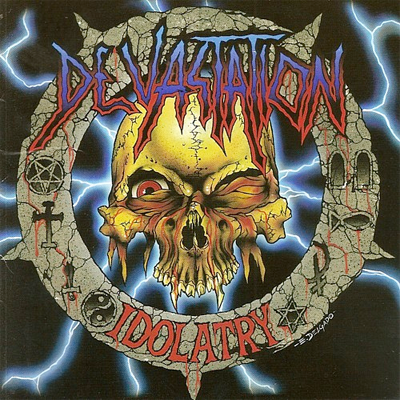
LEPER, Laz (1992, demo)
The skull:
An angry skull with fangs, beady eyes and a biomechanical mane of horns and spikes and pipes, this skull isn’t much to look at, but he has a serious attitude. He’s probably furious that someone drew an “L” on his forehead while he was passed out. “You assholes! That’s permanent marker! I don’t care how wasted I was, this isn’t fucking funny. I have a big interview with the Voivod tomorrow and if I can’t get this washed off by then, I’m seriously gonna kill you guys. I don’t even LIKE Leper!”
The music:
I haven’t heard Laz. Seemingly no one has. There are no YouTube videos, no mp3s on Russian metal forums, no torrents, nothing. As far as I can tell, there are exactly two references to this demo on the entire internet. One is the entry on Metal Archives, from which we cribbed this fine skull. The second, bizarrely, is an Amazon listing. A single seller lists a sealed copy of Laz (complete with price sticker residue), and although the artwork is different, the tracklist agrees with the one on Metal Archives. On the original full scan of the skull-fronted cover which can be seen on Metal Archives, a note on the second panel of the J-card reads, “For full color sleeve send $1.00 check or money order made payable to Rick Bettencourt. This sleeve must accompany payment.” The color cover shown on Amazon is so singularly uninteresting that anyone who might have entered into that transaction with Mr. Bettencourt surely wound up disappointed and angry, and might perhaps have sent the color cover back, requesting a refund of the dollar and a return of the original, skull-emblazoned insert. Given that this cassette is sealed, though, it’s possible that there existed a pressing which never included the skull cover, deepening the mystery and no doubt enhancing the collectability of the skully original. And now, dear reader, let me attempt to illustrate the insanity that occasionally grips this friar, by saying that I briefly had that $16.45 cassette (plus $3.99 shipping) in my Amazon shopping cart, such is my zeal to bring you the most accurate information possible about even the obscurest Big Dumb Skull. In the end, or at least for the moment, common sense prevailed, and I removed the cassette from my cart. Common sense, that is, and the fear that expedited shipping would be required to make deadline, as we at Skull HQ don’t shuffle skulls once they’re set in their order. Leper’s Laz, in its full-color, skulless, high-bias glory, remains for sale on Amazon, waiting to be bought, the last earthly proof that this “Heavy Metal” band from New Bedford, MA ever existed. Perhaps it is a lost classic, a demo of unrivaled excellence, a release that could have changed the direction of metal forever. Perhaps it is shitty funk thrash. I would love to know, but even I have my limits. Those limits evidently amount to $20.44.
— Friar Johnsen








